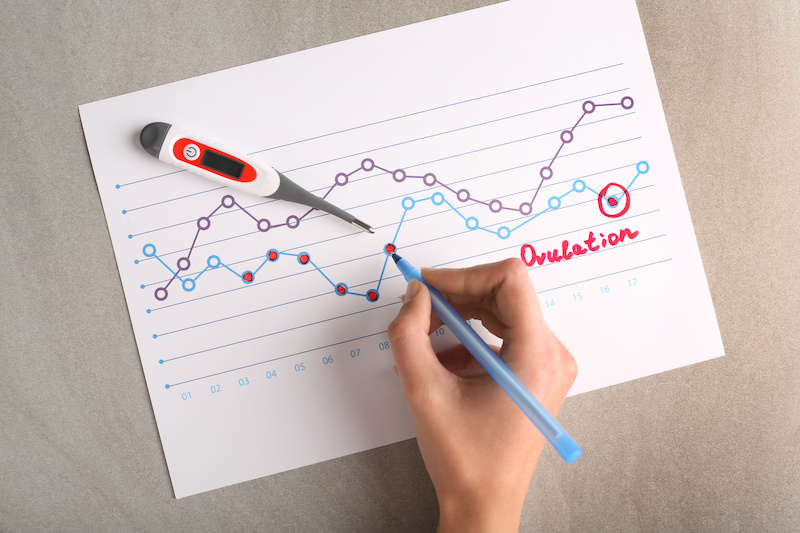Ovulation is a key part of the menstrual cycle and is the process that brings eggs from the ovaries into the uterus so they may be fertilized.
If you are trying to conceive or are using natural family planning and fertility awareness methods such as the rhythm method for birth control, it is important that you understand the process of ovulation.
The American Pregnancy Association is a great source for learning more in-depth about the process of ovulation and how you can track it, but here some basic things to help you gain a better overall understanding of ovulation.
Ovulation and the Menstrual Cycle
Ovulation is the part of the menstrual cycle in which a mature egg is released from an ovary and travels through one of the fallopian tubes and towards the uterus where it may be fertilized by sperm.
During the menstrual cycle, an egg will mature in an ovary. When it is mature, it will be released from its follicle and the ovary itself to make the journey towards the uterus and the possibility of fertilization.
While the egg has been maturing, the uterine lining has also been thickening in anticipation of a fertilized egg implanting in the uterine wall. A menstrual period occurs when there is no fertilization or implantation and the uterus sheds the lining and the egg with it.
Without ovulation, natural conception cannot be achieved. To successfully conceive there are several processes that depend on each other. Ovulation is one of those key processes that enable procreation.
Tracking Ovulation
Perhaps the easiest and most accurate way to find out if you’re ovulating is by using a testing kit. These over-the-counter kits test your urine for increases in certain hormones to determine the likelihood of ovulation.
You can also keep track of when you might be ovulating by tracking your menstrual cycle. In a typical 28-day menstrual cycle, ovulation occurs about 14 days before the next menstrual period starts. But in practice, the menstrual cycle is not always 28 days precisely. In most women, ovulation happens in the four days before or after the midpoint of the cycle. So, you can calculate ovulation by keeping a menstruation calendar, finding the midpoint, and then identifying days you are most likely to be ovulating.
There are also a few physical signs you might notice that can indicate you are ovulating. These include changes in basal body temperature and vaginal secretion.
Your basal body temperature is the temperature of your body when it is at rest. During ovulation, basal body temperature will increase. You can monitor this by using a thermometer specifically made for taking basal temperature to record your temperature at the same time each morning before you get out of bed. You can use this recorded data to see patterns in temperature each month. You are most fertile the two to three days before your temperature rises.
Vaginal secretion changes during ovulation and becomes clearer, stretchy, wet, and less viscous. This is due to an increase in the cervical mucus needed for ovulation. Many women will notice this difference because when they are not ovulating, secretions are less noticeable and may be cloudy and thick.
Ovulation Facts and Stats
Here are some facts and statistics to keep in mind as you begin to track your cycle in preparation for conception or for fertility-awareness-based birth control:
- Stress or illness can affect ovulation and alter the menstrual cycle.
- Spotting (light bleeding) sometimes occurs during ovulation for certain women.
- Some women experience pain or aching near the ovaries during ovulation. This is referred to by the German term “mittelschmerz,” which translates to “middle pain.”
- You can have a menstrual period even if you have not ovulated.
- You can ovulate without having a menstrual period.
- An egg lives between 12 and 24 hours after leaving the ovary. If it is not fertilized during that time period it will disintegrate and be absorbed by the uterine lining.
- Implantation of a fertilized egg generally occurs 6-12 days after ovulation.
- Women are born with all the eggs they will ever have. The ovaries start out with millions of immature eggs.
- Typically, only one egg is released during natural ovulation. This number may increase when using fertility treatments. Ovarian stimulation is often achieved with hormones and other medications so that multiple eggs will be released and can, in turn, be harvested for IVF or cryopreservation.
—
GreenValley OB/GYN was founded over 70 years ago and has been committed to providing the highest quality to the women of the Triad ever since. Our certified OB/GYN physicians and our fantastic staff are dedicated to working with patients to achieve health goals and maintain
